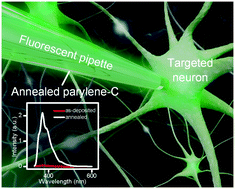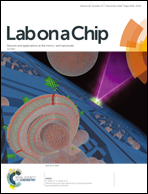Enhanced parylene-C fluorescence as a visual marker for neuronal electrophysiology applications†
Abstract
Parylene-C is a popular polymer material in biomedical applications, with excellent physicochemical properties and microfabrication capability. Like many aromatic polymers, parylene-C also has autofluorescence, which was usually taken as a negative background noise in biomedical detection studies. However, the fluorescence intensity of thin-film (<1 μm) parylene-C was relatively weak, which may be a big limitation in visualization. In this work, we reported a simple annealing method to significantly enhance the fluorescence and achieve sufficient intensity as a visual marker. We studied the behaviors and mechanisms of the enhanced parylene-C fluorescence, then verified the feasibility and reliability of parylene-C for preparing fluorescent pipettes in targeted neuronal electrophysiology, where fluorescent guidance was strongly needed. The powerful parylene-C fabrication technique enables a precisely-controlled conformal coating along with a mass production capability, which further resulted in high-quality electrophysiological recordings of both cultured hippocampal neurons and acute hippocampal brain slices. Moreover, the enhanced parylene-C fluorescence can also be applied in more general biological operations, such as designable fluorescent micro-patterns for visualization in broader biomedical fields.



 Please wait while we load your content...
Please wait while we load your content...